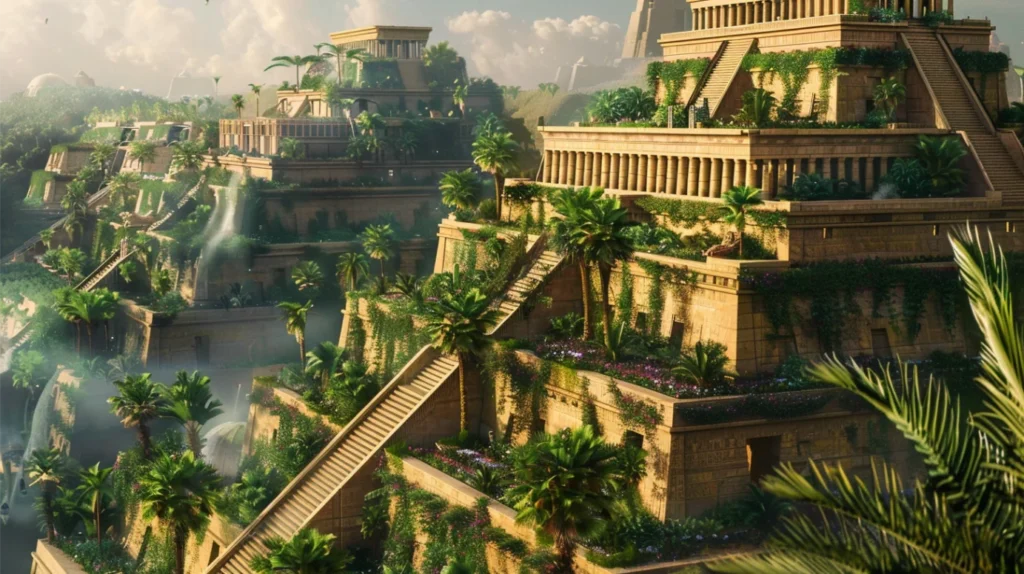The images in our articles may not match the content exactly. They are used to grab your attention, not to show the exact details in the text. The images complement the text but do not replace it.
The Hanging Gardens of Babylon, one of the Seven Wonders of the Ancient World, stand as a timeless symbol of love, ingenuity, and cultural richness. Nestled in the heart of ancient Babylon, these gardens have captured the imagination of historians, archaeologists, and enthusiasts alike. Join us on a journey through time as we uncover the fascinating history, engineering marvels, and cultural significance of this iconic wonder.
The Hanging Gardens of Babylon: A Marvel of Ancient Engineering
Dive into the enigmatic beauty and engineering wonders of the Hanging Gardens of Babylon with 34 intriguing facts about this legendary creation. From its mysterious origins to its status as a symbol of human ingenuity, each detail unveils a rich tapestry of history and myth surrounding this ancient marvel.
The Gardens’ Mysterious Origins
The Hanging Gardens of Babylon are believed to have been built in ancient Babylon, near present-day Hillah, Babil, in Iraq. Lush greenery, vibrant flora, and towering trees created a stark contrast to the arid Mesopotamian landscape. The gardens are often attributed to the Neo-Babylonian king Nebuchadnezzar II, who ruled from 605-562 BCE, showcasing a testament to love and devotion.
A Feat of Hydraulic Engineering
An intricate system of terraces and aqueducts enabled the gardens to flourish in a desert environment. The gardens were irrigated using a sophisticated system that lifted water from the Euphrates River to nourish the plants, showcasing the innovative spirit of the Babylonians.
A Symbol of Power and Wealth
The gardens served as a showcase of the wealth and power of the Babylonian empire, highlighting the opulence and grandeur of the ruling elite. Fragrance of exotic flowers perfumed the air, creating a sensory delight for visitors and residents alike.
A Lost Wonder
Despite the ongoing debate about the gardens’ existence, their cultural significance has led to suggestions for their recognition as a UNESCO World Heritage Site. The enduring mystery surrounding their exact location and fate adds to their mystique and intrigue.
Unveiling the Cultural Significance of the Hanging Gardens

The Hanging Gardens of Babylon transcend mere architectural marvels, reflecting a deeper cultural context and symbolic significance. Let’s explore the layers of meaning behind this ancient wonder and its impact on art, literature, and historical inquiry.
A Subject of Artistic Interpretation
Artists throughout history have sought to capture the ethereal beauty and enchanting allure of the gardens in their works. Each interpretation infuses a sense of otherworldly enchantment, reflecting the timeless appeal of this ancient wonder.
A Symbol of Cultural Identity
The homage to Queen Amytis’ homeland through the design of the gardens illustrates a poignant symbol of cultural identity and remembrance. The gardens served as a sanctuary of tranquility amidst the bustling city of Babylon, offering a space for reflection and connection to one’s roots.
A Testament to Enduring Legacy
The legacy of the Hanging Gardens of Babylon serves as a testament to the indelible mark left by ancient civilizations on the tapestry of human history. Historians and scholars continue to unravel the mysteries surrounding the gardens, delving into ancient texts and archaeological evidence to unveil their enigmatic story.
A Symbol of Ethereal Beauty
With their ethereal beauty and enchanting allure, the gardens continue to evoke wonder and reverence across the ages. Their timeless appeal transcends boundaries of time and space, leaving a lasting impression on all who encounter their mystique.
Embracing the Legacy of the Hanging Gardens
The Hanging Gardens of Babylon remain a source of inspiration and contemplation for future generations, inviting us to reflect on the enduring human desire for beauty, harmony, and the sublime. As we unravel the enigmatic legacy of this ancient marvel, we are reminded of the timeless wonder and intrigue that continue to captivate our imagination.
Conclusion
In conclusion, the Hanging Gardens of Babylon symbolize the ingenuity, creativity, and cultural richness of ancient civilizations. Whether a product of historical records or myth, their enduring legacy stirs our curiosity and sparks our imagination. As we delve into the mysteries surrounding this ancient wonder, we are reminded of the human spirit’s relentless pursuit of beauty and wonder, transcending time and space.
FAQs
What were the Hanging Gardens of Babylon?
The Hanging Gardens of Babylon were a legendary architectural marvel, described by ancient writers as a series of terraced gardens adorned with lush vegetation and exotic flora. While their existence is debated, they are believed to have been an extraordinary feat of engineering and horticulture.
Where were the Hanging Gardens of Babylon located?
The exact location of the Hanging Gardens of Babylon remains a subject of debate among historians and archaeologists. While some theories suggest they were situated in present-day Iraq, near the Euphrates River and the city of Babylon, there is no definitive evidence to pinpoint their exact location.






